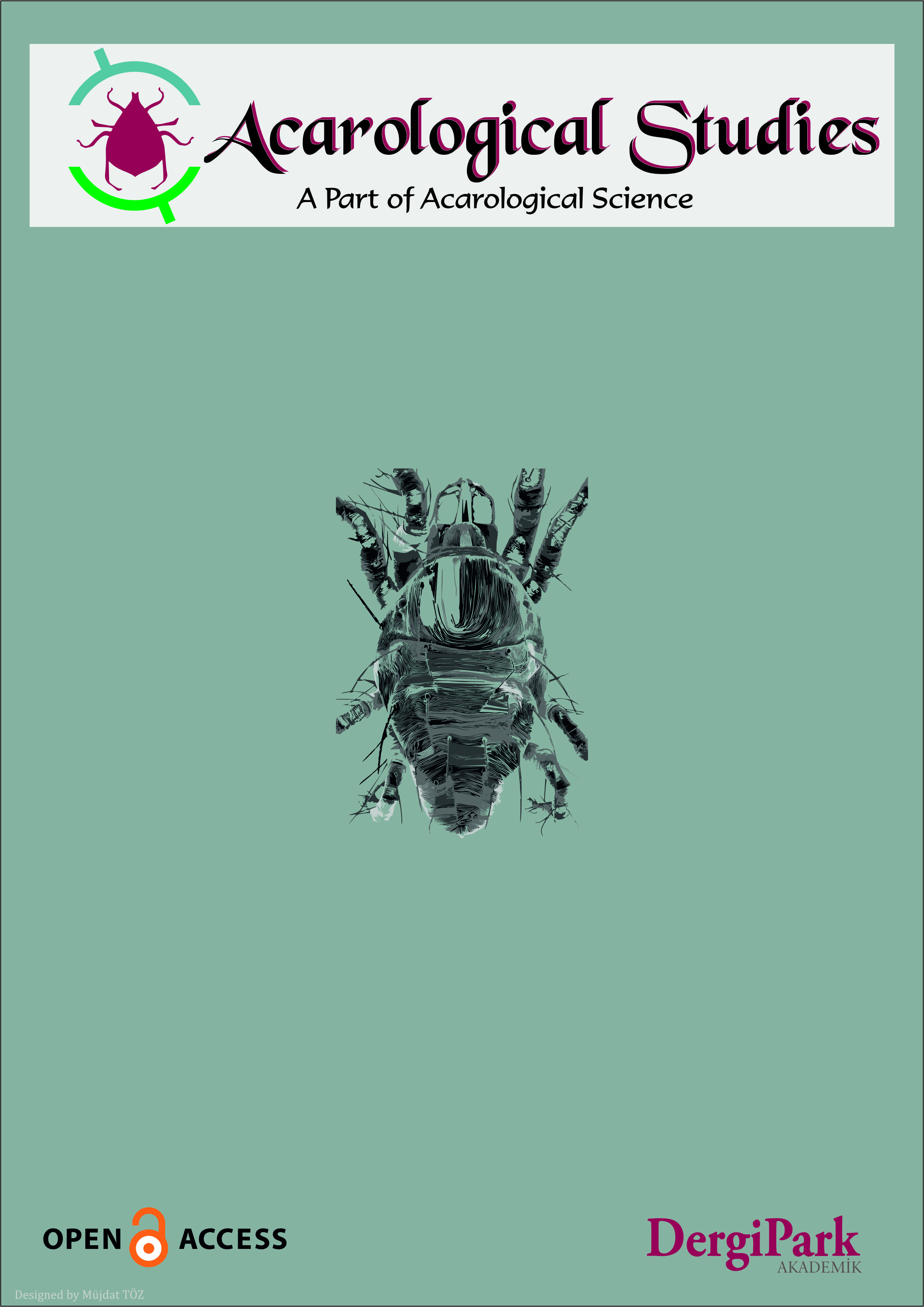First report of abnormal morphology in the tick Dermacentor dissimilis (Acari: Ixodidae) and evidence of molt nymph-adult on hosts from Nicaragua
First report of abnormal morphology in the tick Dermacentor dissimilis (Acari: Ixodidae) and evidence of molt nymph-adult on hosts from Nicaragua
Dermacentor dissimilis malformations, ectromely, two-hosts tick,
___
- Apanaskevich, D. and Bermúdez, S. 2013. Description of a new Dermacentor species, a parasite of wild mammals in Central America. Journal of Medical Entomology, 50: 1190-1201. doi: 10.1603/ME13121
- Bermúdez S., Mejía L., Hernández L. and Apanaskevich D. 2015. First records of Ixodes boliviensis Neumann, 1904 and Dermacentor dissimilis Cooley, 1947 (Ixodida: Ixodidae) as parasites of domestic mammals in Nicaragua. Systematic and Applied Acarology, 20 (4): 462-464. doi: 10.11158/saa.20.4.12
- Buczek, A., Bartosik, K., Buczek, S. and Zajac, Z. 2017. Anomalies in Hyalomma marginatum larvae (Acari: Ixodidae) in relation to taxonomic studies. Systematic and Applied Acarology, 22 (3): 423-430. doi: 10.11158/saa.22.3.8
- Camicas, J., Hervy, J., Adam, F. and Morel, P. 1998. Les Tiques du Monde. Nomenclature, Stades Décrits, Hôtes, Répartition (Acarida, Ixodida). Éditions de L'Orstom. Paris, 223 pp.
- Campana-Rouget, Y. 1959a. La tératologie des tiques. Annales de Parasitologie Humaine et Comparee, 34: 209-260. doi: 10.1051/parasite/1959341209
- Campana-Rouget, Y. 1959b. La tératologie des tiques (fin). Annales de Parasitologie Humaine et Comparee, 34: 354-431. doi: 10.1051/parasite/1959343354
- Chitimia-Dobler, L. and Pfeffer, M. 2017. Gynandromorphism and local morphological abnormalities in Dermacentor reticulatus (Acari: Ixodidae). Systematic and Applied Acarology, 22 (4): 449-455. doi: 10.11158/saa.22.4.1
- Chitimia-Dobler, L., Bestehorn, M., Bröker, M., Borde, J., Molcanyi, T., Andersen, N., Pfeffer, M. and Dobler, G. 2017. Morphological anomalies in Ixodes ricinus and Ixodes inopinatus collected from tick-borne encephalitis natural foci in Central Europe. Experimental and Applied Acarology, 72:379-397. doi: 10.1007/s10493-017-0163-5
- Cooley, R. 1947. Dermacentor dissimilis, a new species of ticks from southern Mexico. American Museum Novitates, 1332: 1-3.
- Dergousoff, S. and Chilton, N. 2007. Abnormal morphology of an adult Rocky Mountain wood tick, Dermacentor andersoni (Acari: Ixodidae). Journal of Parasitology, 93: 708-709. doi: 10.1645/GE-1073R.1
- Guglielmone, A. Castella, A., Mangold, A., Estrada-Peña, A., Viñabal, E. 1999. Phenotypic anomalies in a collection of Neotropical ticks (Ixodidae). Acarologia, 40: 127-132.
- Guglielmone, A., Estrada-Peña, A., Keirans, J. and Robbins R. 2003. Ticks (Acari: Ixodida) of the Neotropical zoogeographic region. International Consortium on Ticks and Tick-Borne Diseases, Houten, The Netherlands, 173 pp.
- Guglielmone, A., Robbins, R., Apanaskevich, D., Petney, T., Estrada-Peña, A. and Horak, I. 2014. The Hard Ticks of the World (Acari: Ixodida: Ixodidae). Springer, Dordrecht, xiii. 738 pp.
- Guzmán-Cornejo C., Robbins, R., Guglielmone, A., Montiel-Parra, G., Rivas, G. and Pérez, T. 2016. The Dermacentor (Acari, Ixodida, Ixodidae) of Mexico: hosts, geographical distribution and new records. ZooKeys, 569: 1-22. doi: 10.3897/zookeys.569.7221
- Homsher, P. and Yunker, C. 1981. Bilateral gynandromorphism in Dermacentor andersoni (Acari:Ixodidae): morphological and cytogenetic analysis. Journal of Medical Entomology, 18, 89-91. doi: 10.1093/jmedent/18.1.89
- Kar, S., Akyildiz, G., Yilmazer, N., Shaibi, T., Gargili, A. and Vatansever, Z. 2015. External morphological anomalies in ixodid ticks from Thrace, Turkey. Experimental and Applied Acarology, 67: 457-466. doi: 10.1007/s10493-015-9948-6
- Kohls, G. and Dalmat, H. 1952. The male of Dermacentor dissimilis Cooley (Acarina: Ixodidae). The Journal of Parasitology, 38 (2): 144-142. doi: 10.2307/3273832
- Labruna, M., Ribeiro, A., Cruz, M., Camargo, L. and Camargo, E. 2002. Gynandromorphism in Amblyomma cajennense and Rhipicephalus sanguineus (Acari: Ixodidae). The Journal of Parasitology, 88: 810-811. doi: 10.1645/0022-3395(2002)088[0810:GIACAR]2.0. CO;2
- Muñoz-Leal, S., Martins, T., Luna, L., Rodriguez, A. and Labruna, M. 2018. A new collection of Amblyomma parvitarsum (Acari: Ixodidae) in Peru, with description of a gynandromorph and report of Rickettsia detection. Journal of Medical Entomology, 55 (2): 464-467. doi: 10.1093/jme/tjx194
- Neumann, L. 1899. Anomalie d'ixodidés. Archives Parasitologie, 2: 463-465.
- Nowak-Chmura, M. 2012. Teratological changes in tick morphology in ticks feeding on exotic reptiles. Journal of Natural History, 46: 911-921. doi: 10.1080/00222933.2011.651635
- Oliver, J. and Delfin, E. 1967. Gynandromorphism in Der-macentor occidentalis (Acari:Ixodidae). Annals of the Entomological Society of America, 60: 1119-1121.
- Rivera-Páez F., Larbuna M., Martins T., Rodrigues-Sampieri B. and Camargo-Mathias M. 2017. A case of gynandromorphism in Amblyomma mixtum (Acari. Ixodidae). Revista Colombiana de Entomología, 43 (2): 268-270. doi: 10.25100/socolen.v43i2.5956
- Robinson, L. 1920. Malformations in ticks. Parasitology, 12: 175-179. doi: 10.25100/socolen.v43i2.5956
- Tovornik, D. 1987. Teratological forms of ixodid ticks. Bioloski Vestnik, 35: 91-100.
- Yunker, C., Keirans, J., Clifford, C. and Easton, E. 1986. Dermacentor ticks of the New World: a scanning electron microscope atlas. Proceeding of the Entomological Society of Washington, 88: 609-627.
- Yayın Aralığı: 2
- Başlangıç: 2019
- Yayıncı: -
Mehmet KARACA, Raşit URHAN, Elif Hilal DURAN
Checklist of the Hungarian species of family Macrochelidae (Acari: Mesostigmata)
Raşit URHAN, Mehmet KARACA, Elif Hilal DURAN
Lillian G. DOMÍNGUEZ, Sergio E. BERMÚDEZ, Ricardo MORENO, Josué ORTEGA
Ayşegül TAYLAN ÖZKAN, Kosta Y. MUMCUOGLU
Phytoseiid species (Acari: Phytoseiidae) on walnut trees in Samsun Province, Turkey
Şeyma ÇAKIR, Marie - Stephane TIXIER, Sebahat K. OZMAN-SULLIVAN
Pülümür Vadisi’nden (Türkiye) yeni bir Stigmaeus Koch (Acari, Stigmaeidae) Türü
A new species of the genus Trombidium (Acari: Trombidioidea) parasitic on a spider species in Turkey
